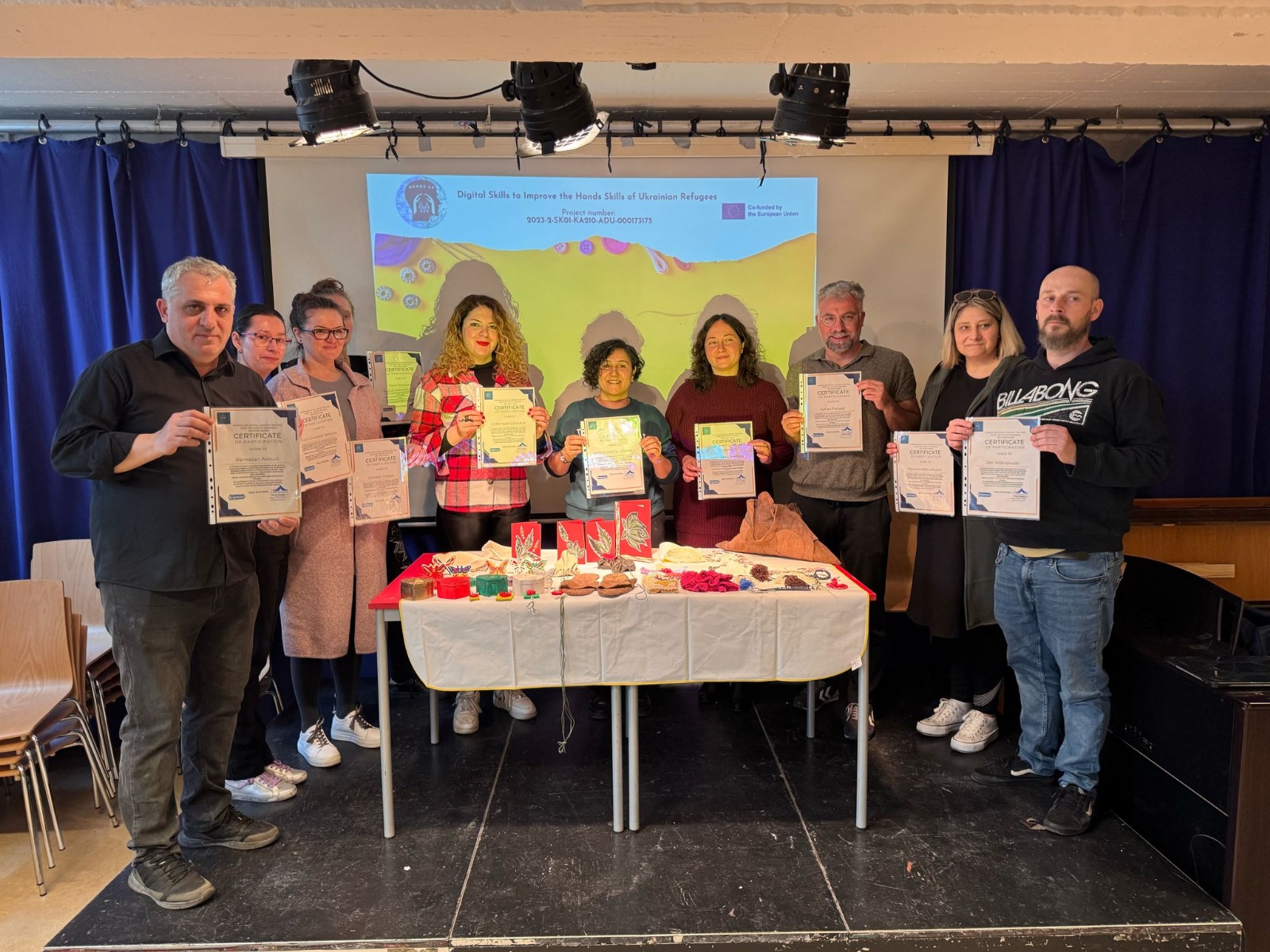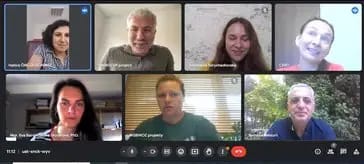The Erasmus+ project “Digital Content to Improve the Hand Skills of Ukrainian Refugees” took a significant step forward in Bremen, Germany. Participants came together for an intense two-day training session aimed at developing digital content for refugees. The training focused on equipping participants with the necessary skills to teach practical skills that will improve the lives of refugees.
Day 1: Project Goals and Summary of Previous Activities
On the first day, the project’s goals and objectives were thoroughly explained to the participants. Coordinators from Slovakia provided a summary of previous activities and shared academic insights they gained about digital content creation. Following this, participants visited Ukrainian refugee families in Germany, where presentations on digital education content were given to provide context and relevance to the project.
Day 2: Digital Content Creation Workshops
On the second day, participants were divided into four groups, each working on creating digital content for different topics related to the needs of refugees. Below are the topics and goals each group focused on:
Group A: This group worked on creating digital content to teach refugee women simple sewing techniques for home use. The content focused on repurposing old clothes into new styles, providing practical skills for refugees to create clothing from unused items.
Group B: The second group developed digital content aimed at improving the handcraft skills of refugee women, focusing on knitting techniques for creating hats, scarves, vests, sweaters, and more.
Group C: This group focused on creating digital content to teach refugees how to make souvenirs. The content also covered marketing these handmade items, providing insights into how refugees can sell their creations.
Group D: The fourth group developed digital content focused on the harmful effects of global warming, aiming to raise awareness among refugees. Additionally, they created content on how to grow and care for garden plants in pots, which refugees could cultivate in their homes.Group Work and Asynchronous Content Development
Each group worked collaboratively to develop asynchronous content. The groups created a detailed plan, defined topics, and mapped out the content through concept maps. They also wrote texts to explain the work that would be included in the digital content. The participants conducted video shoots and recordings, which were incorporated into the asynchronous content.
Taking the Project a Step Further
This two-day event not only helped create valuable digital educational content for Ukrainian refugees but also allowed participants to enhance their skills and work more effectively with refugee populations. The project aims to foster the integration and economic independence of refugees by providing them with accessible digital learning tools.



E aí, pessoal, a confiável mesmo? Alguém já teve alguma experiência boa ou ruim por lá? Queria saber antes de colocar meu dinheiro.
Interesting read! Seeing more platforms like nino gaming app download apk focusing on verifiable fairness (RTP 94-98% is great!) builds trust. Smart for PH players to know the odds! 🤔
Interesting analysis! It’s smart to consider the psychological side of gaming – platforms like the pesowin app are prioritizing responsible play, which is a huge step forward. Balancing fun & wellbeing is key! 🤔
Interesting points about building a solid foundation in online gaming! It’s crucial to understand the basics – account security & responsible play. Speaking of foundations, exploring resources like jljl1 login can really help newcomers navigate the landscape safely & effectively.
Basic strategy really shifts your perspective – understanding the ‘why’ behind each decision is key! Seeing platforms like 2jl app emphasize secure logins & verified RNGs builds trust, crucial for long-term play. It’s about informed choices!
Really interesting read! Seeing platforms like jlph63 game focus on localized payment options (GCash, PayMaya!) is HUGE for Filipino players. Makes everything so much smoother & more accessible. Great analysis! 👍
Turkey nightlife tours Outstanding Turkey tour packages. The attention to detail and customer service was exceptional. http://sandrazimmermann.de/?p=121908
**mindvault**
mindvault is a premium cognitive support formula created for adults 45+. It’s thoughtfully designed to help maintain clear thinking
Bulk commenting service. 100,000 comments on independent websites for $100 or 1000,000 comments for $500. You can read this comment, it means my bulk sending is successful. Payment account-USDT TRC20:【TLRH8hompAphv4YJQa7Jy4xaXfbgbspEFK】。After payment, contact me via email (helloboy1979@gmail.com),tell me your nickname, email, website URL, and comment content. Bulk sending will be completed within 24 hours. I’ll give you links for each comment.Please contact us after payment is made. We do not respond to inquiries prior to payment. Let’s work with integrity for long-term cooperation.
**breathe**
breathe is a plant-powered tincture crafted to promote lung performance and enhance your breathing quality.
Hi, how have you been lately?
Interesting read! The speed of access is a huge factor for me – waiting ages to play is a real buzzkill. I saw wk777 login boasts quick play & withdrawals, which sounds ideal for fitting gaming into a busy schedule. Definitely a plus!
Interesting analysis! Seeing how patterns emerge is key, even in games of chance. Platforms like bigbunny slot are evolving, offering personalized experiences-it’s about more than just luck now, right? Data-driven gaming is fascinating!
真免费!价值万元资源,不要一分钱,网址:https://www.53278.xyz/
Interesting points about bankroll management! Seeing platforms like kkkjili app prioritize quick, local payments (GCash, PayMaya) is smart for accessibility. Secure accounts are key, too – two-factor authentication is a must for any online gaming!
It’s so important to remember gaming should be fun, not a source of stress. Seeing platforms like sz7777 com focus on engagement and responsible play is a positive step. A smooth login & deposit process can help, but awareness is key! ✨
益群网:终身分红,逆向推荐,不拉下线,也有钱赚!尖端资源,价值百万,一网打尽,瞬间拥有!多重收益,五五倍增,八级提成,后劲无穷!网址:1199.pw
Solid article! Thinking about bankroll management & game selection is key to long-term success. Platforms like money88 online casino emphasize responsible gaming & diverse options, which is great to see. Good read!
That’s a solid analysis – understanding value is key in any competitive scene! Seeing platforms like jljl77 app focus on rewards & easy access (like GCash!) could really change the game for PH players. Smart move!
Alright, checking out 68jili. The selection is decent, and it runs smoothly. Could be a cool spot to spend a few hours if you’re into that! Good luck guys!
Really digging this breakdown of basic strategy! It’s cool to see how even beginners can improve. Thinking about trying out some online games – heard bet888 ph online casino is popular in the Philippines & offers lots of options! Great post!
Fascinating read! The evolution of gaming is incredible – from simple dice games to today’s sophisticated platforms. Speaking of platforms, I checked out swertegaming slot and their focus on secure, user-friendly experiences seems key for growth in the SEA market. Great article!
Interesting analysis! The shift to digital casinos, like what lawinplay download apk offers, really mirrors how gaming evolved in the Philippines – a natural progression from tradition! Solid points about responsible gaming too.
Yo! 711php is calling my name. I’m diving in. Wish me luck! Anyone had any big wins here? Let’s get it! Peep this out 711php!
Thanks for sharing. I read many of your blog posts, cool, your blog is very good.
That’s a solid point about responsible gaming! Seeing platforms like jljl1 ph app casino prioritize security & KYC is reassuring – crucial for a smooth, trustworthy experience, especially with mobile access. It’s a game changer!
Your article helped me a lot, is there any more related content? Thanks!